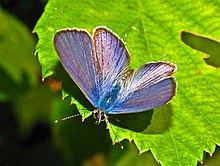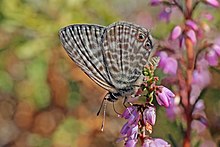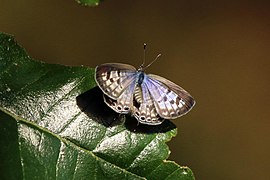Leptotes pirithous
| Leptotes pirithous | |
|---|---|

| |
| Male, dorsal view, Italy | |

| |
| Male ventral view, Portugal | |
| Scientific classification | |
| Domain: | Eukaryota |
| Kingdom: | Animalia |
| Phylum: | Arthropoda |
| Class: | Insecta |
| Order: | Lepidoptera |
| Family: | Lycaenidae |
| Genus: | Leptotes |
| Species: | L. pirithous
|
| Binomial name | |
| Leptotes pirithous (Linnaeus, 1767)
| |
| Synonyms | |
| |
Leptotes pirithous, the Lang's short-tailed blue or common zebra blue, is a butterfly of the family Lycaenidae.
Description
Leptotes pirithous is a small butterfly with a wingspan of 21–29 mm in males and 24–30 mm in females. The uppersides of the wings are purple bluish in males, bluish brown in female. The undersides are dark beige striped with white lines. The hindwings show marginal orange and black spots and two small tails. For the design of the undersides of the wings they can be confused with Lampides boeticus and Cacyreus marshalli. These butterflies fly from February to November depending on the location. They are regular migrants.
The larvae feed on the flowers and fruits of Fabaceae, Rosaceae and Plumbaginaceae species, including Plumbago capensis, Indigofera, Rynchosia, Vigna, Burkea, Mundulea, Melilotus, Crataegus, Quercus suber, Medicago sativa, Trifolium alexandrium, Arachis hypogaea, Lythrum, Calluna, Genista, Dorycnium, Lythrum salicaria, Calluna vulgaris, Onobrychis viciifolia, Ulex and Melilotus alba. A life cycle takes about four to eight weeks, depending on the temperature.
- A courtship ritual in iSimangaliso Wetland Park, KwaZulu-Natal, South Africa
-
L. p. pirithous, 1 of 3
male on left -
L. p. pirithous, 2 of 3
female covers male -
L. p. pirithous, 3 of 3
female on male
Distribution
This species can be found in southern Europe (Spain, France and Italy), along the Mediterranean coast, in Asia Minor up to the Himalayas, and in most of Africa and Madagascar.
Subspecies
- Leptotes pirithous pirithous (southern Europe, Caucasus, Transcaucasia, North Africa)
- Leptotes pirithous capverti Libert, Baliteau & Baliteau, 2011 (Cape Verde: island of Santo Antão: Lombo de Figueira)
- Leptotes pirithous insulanus (Aurivillius, 1924) (Mozambique)
Habitat
This species prefers varied wasteland, cultivated areas and gardens.
External links
- Leptotes at Markku Savela's website on Lepidoptera



